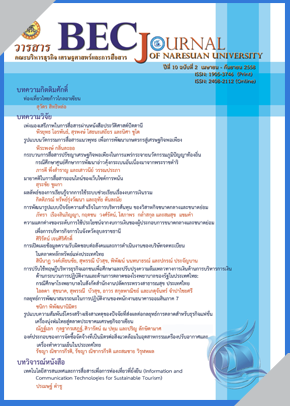รูปแบบนวัตกรรมการสื่อสารแนวพุทธ เพื่อการพัฒนาเกษตรกรสู่เศรษฐกิจพอเพียง
Main Article Content
บทคัดย่อ
งานวิจัยรูปแบบนวัตกรรมการสื่อสารแนวพุทธเพื่อการพัฒนาเกษตรกรสู่เศรษฐกิจพอเพียง เป็นการวิจัยเชิง เอกสารและเชิงปริมาณประกอบกันโดยเริ่มศึกษาผลของการพัฒนาด้วยแผนพัฒนาเศรษฐกิจและสังคมแห่งชาติทั้ง 10 แผน เปรียบเทียบกับผลของการปรับเปลี่ยนพฤติกรรมของกลุ่มตัวอย่าง ซึ่งผ่านกระบวนการวิธีสื่อสารแนวพุทธ กับการพัฒนาเกษตรกร ด้วยปรัชญาของเศรษฐกิจพอเพียง ศึกษาว่าจะมีผลสู่ความยั่งยืนต่างกันอย่างไร ผลการ วิเคราะห์พบว่า ความต้องการในการพัฒนาของเกษตรกรและการตอบสนองของปัจจัยการพัฒนาจะเกิดความสมดุล โดยผ่านการตรวจสอบจากผลที่เกิดขึ้นต่อเศรษฐกิจ การศึกษา ศรัทธาและความเชื่อมั่น การมีส่วนร่วมทางสังคมและ คุณภาพชีวิตในกลุ่มตัวอย่าง โดยการสื่อสารแนวพุทธจะเป็นจุดเชื่อมความสมดุลที่ทำให้เกิดการปรับเปลี่ยน พฤติกรรมของเกษตรกรไปในทิศทางที่ทำให้เกิดปัญญาและความสุขที่ยั่งยืน เมื่อความรู้ที่ถูกส่งไปให้เกษตรกรปฏิบัติ เพื่อก่อเกิดปัญญารู้แจ้งในการพัฒนานั้น อยู่ภายใต้กรอบปรัชญาของเศรษฐกิจพอเพียงที่ประยุกต์ความพอประมาณ เข้ากับทฤษฎีการผลิต การตลาด และการบริโภคของเศรษฐศาสตร์กระแสหลักที่กำกับด้วยพุทธเศรษฐศาสตร์และ หลักธรรมมัชฌิมาปฏิปทา, มรรคมีองค์ 8, ไตรสิกขา, ปฏิจจสมุปบาท, สัปปุริสธรรม 7, เบญจศีล - เบญจธรรม ส่วน ความมีเหตุและผลนั้นกำกับด้วยหลักธรรมโยนิโสมนสิการ, ไตรลักษณ์, อริยสัจ 4, อิทธิบาท 4, สังคหวัตถุ 4, พรหม วิหาร 4 ด้วยภูมิคุ้มกันที่มีสติ - อัปมาทธรรม และกัลยาณมิตรธรรม กำกับบนฐานความรู้คู่คุณธรรมที่เข้มแข็งได้ด้วย พหูสูตร, อายตนะ 6 ที่มีหิริ โอตัปปะความละอายและเกรงต่อบาป ต่อการทุจริตเป็นจุดเริ่มต้น และจากการ สังเคราะห์พบว่า รูปแบบที่สมบูรณ์ของการตอบสนองปัจจัยการพัฒนาและความต้องการในการพัฒนาคือ จุดสมดุล ของความต้องการและการตอบสนองที่ถูกเชื่อมต่อเนื่องกันไปจนเป็นกราฟเส้นตรงเส้นเดียวกัน ดังนั้นรูปแบบ นวัตกรรมการสื่อสารแนวพุทธเพื่อการพัฒนาเกษตรกรสู่เศรษฐกิจพอเพียง จึงประกอบไปด้วย 5 ทฤษฎีหลัก 15 หลักธรรมกำกับและวัดผลด้วย 15 ดัชนี ซึ่งรูปแบบนวัตกรรมในงานวิจัยครั้งนี้ยังสามารถปรับใช้ในประเทศที่แตกต่าง ทั้งเศรษฐกิจ สังคม สิ่งแวดล้อมและวัฒนธรรม เพราะสังเคราะห์จากหลักของธรรมชาติคือ หลักธรรม
The Innovative Model of the Communication Based on Buddhism for the Development of the Farmers towards Sufficiency Economy
The Innovative Model of the Communication Based on Buddhism for the Development of the Farmers towards Sufficiency Economy is a qualitative method and quantitative method namely a research analysis is employed from all 10 editions of National Economic and Social Development Plan which are compared to the change from sampling behaviors. The aims to study the process of the farmers’ development based on the Buddhist way and the implementation through the Sufficiency Economy Philosophy. The research studies how the results of sustainable will different from each. In this research, it is revealed that the need for the development of the farmers and the response of the developmented factors are balanced through the examination of the effects on the economy, the education, the faith, the confidence, the social participation and the quality of life. The Dhamma principles connected with the Buddhist economics have to be modified for the farmers’ success, while the communication based on Buddhism and becomes a point of balance, causing the farmers to modify or change their behaviors in the direction that causes intellectual and lasting happiness towards the Sufficiency Economy Philosophy is developed. Moderation is applied to the productional theory, the marketing and the consumption from mainstream economic effects are directed by the Buddhist economics and the Buddhist principles of the Middle Path (Majjhimãpaṭipadã), the Noble Eightfold Path (Aṭṭhañgika magga), the Threefold Training (Trisikkhã), the Chain of Causation (Paṭiccasamuppāda), the Seven Qualities of a Dood Man (Sappurisadhamma), the Five Precepts (Pañcasila) and the Five Dharma (Pañcadhama). The Reasonability is Regulated by thorough Contemplation (Yonisomanasikāra), the Three Characteristics (Tilakkhaña), the Fourfold Noble Truths (Catu - Ariyasacca), the Four Principles of Success (Catu - Iddhipāda), the Four Principles of Social Integration (Catu - Sangahavatthu) and the Four Principles of Virtuous Existence (Catu - Brabmavihāra). The Self -Immunity Supervised by Mindfulness (Sati - Appamādadhamma) and True Good Friends (Kalyāṇamittatadhamma) in a strong base of knowledge and the morality condition is controlled by the people of knowledge (Bahusutta), Six Channels of Sense (Ãyatanas) that are controlled by the moral shame (Hiri) and the fear to the sin against the corruption (Ottappa) as a starting point. The model of the completion of the response factors of development and the needs of the development are the balance of demand and supply being connected with the same line as linear. There fore, the Innovative Model of the Communication Based on Buddhism for the Development of the Farmers towards Sufficiency Economy Philosophy consists of five main theories, 15 principles of Dharma and the evaluation of 1 5 indexes. The innovative model in this research can also be used in different countries which are of different economices, societies, environments and cultures, because of the synthesises of the natural principles that are Dharmas.
Article Details
เอกสารอ้างอิง
พีระพงษ์ กลิ่นละออ.(2558). รูปแบบนวัตกรรมการสื่อสารแนวพุทธ เพื่อการพัฒนาเกษตรกรสู่เศรษฐกิจพอเพียง. วารสารบริหารธุรกิจ เศรษฐศาสตร์และการสื่อสาร, 10(2), 22-39.


